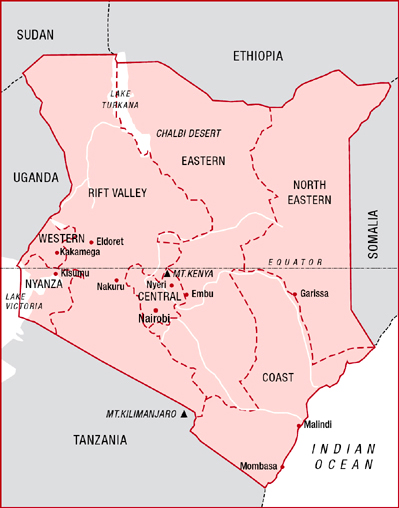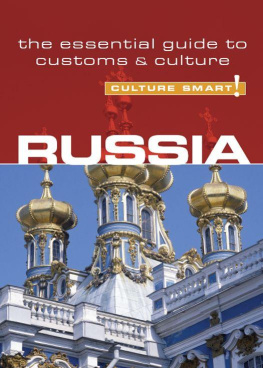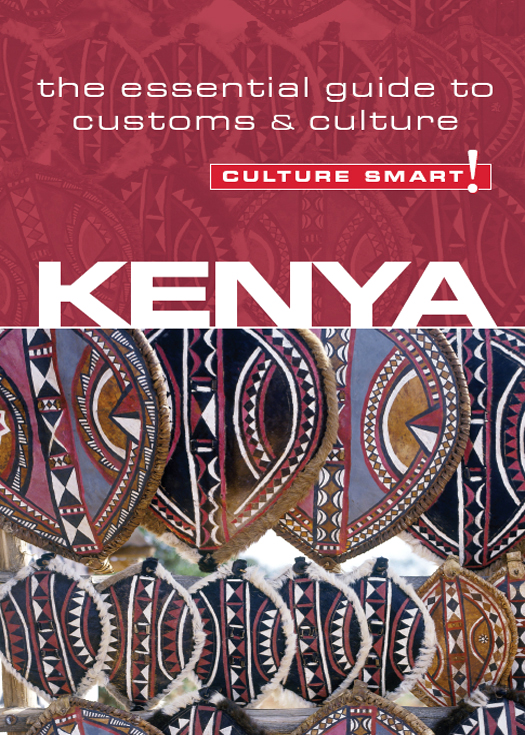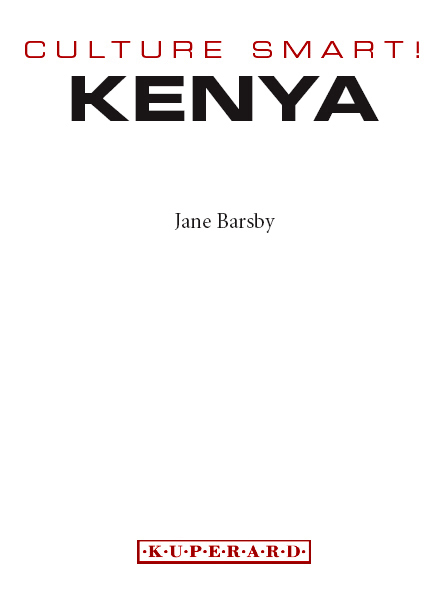First published in Great Britain 2007
by Kuperard, an imprint of Bravo Ltd
59 Hutton Grove, London N12 8DS
Tel: +44 (0) 20 8446 2440 Fax: +44 (0) 20 8446 2441
www.culturesmartguides.com
Inquiries:
Culture Smart! is a registered trademark of Bravo Ltd
Copyright 2007 Kuperard
Fifth printing 2010
All rights reserved. No part of this publication may be reprinted or reproduced, stored in a retrieval system, or transmitted in any form or by any means without prior permission in writing from the publishers.
Series Editor Geoffrey Chesler
eISBN: 978-1-85733-570-5
British Library Cataloguing in Publication Data
A CIP catalogue entry for this book is available from the
British Library
Cover image: Maasai shields. Travel Ink/Philip Craven
v3.1
About the Author
JANE BARSBY is an English journalist, travel writer, and PR consultant who has lived in Kenya for sixteen years. She has featured regularly in magazines such as Travel Africa, Msafiri (the in-flight magazine of Kenya Airways), and Travel News and Leisure East Africa, and is the author of a series of guidebooks on the Kenyan national parks and reserves. Formerly an international conference and exhibition organizer with experience in Africa, China, Russia, Europe, and America, Jane has organized numerous trade exhibitions and conferences in Kenya. She works extensively with the Kenyan hotel and tourism industry, and has also undertaken a number of commissions for the United Nations in Kenya and in Sudan.
The Culture Smart! series is continuing to expand.
For further information and latest titles visit
www.culturesmartguides.com
The publishers would like to thank CultureSmart!Consulting for its help in researching and developing the concept for this series.
CultureSmart!Consulting creates tailor-made seminars and consultancy programs to meet a wide range of corporate, public-sector, and individual needs. Whether delivering courses on multicultural team building in the USA, preparing Chinese engineers for a posting in Europe, training call-center staff in India, or raising the awareness of police forces to the needs of diverse ethnic communities, it provides essential, practical, and powerful skills worldwide to an increasingly international workforce.
For details, visit www.culturesmartconsulting.com
CultureSmart!Consulting and CultureSmart! guides have both contributed to and featured regularly in the weekly travel program Fast Track on BBC World TV.
contents
Map of Kenya

introduction
Known as the Cradle of Mankind, the original Garden of Eden, and the place where, six million years ago, Millennium Man walked the Tugen Hills, Kenya is the ethnic homeland of us all. It was from Kenyas nurturing embrace that the earliest humans wandered forth to colonize the world. On the shores of Lake Turkana, however, where Homo erectus took his first upright steps, little has changed. The searing wind still scours the waters of the Jade Sea, hippos wallow alongside crocodiles, and nomadic tribespeople live a life essentially unchanged from that of their ancestors fifty thousand years ago.
Kenya later became the adopted home of more than seventy different groups of ethnic African migrants, each with its own distinctive cultural identy. It is a land of miraculously harmonious contrasts: tropical ice, teeming wilderness, vibrant culture, and gentle tolerance. A place where, despite the burdens of poverty, drought, and famine, the phrase Hakuna matata (no problem) embodies the national attitude, and a smile is the most valuable currency.
Today fifty-six national parks and reserves offer sanctuary to some of the worlds most ancient and most threatened creatures. The country contains some of the last primordial rain forests and boasts more species of birds than anywhere else on earth. Stunningly scenic, steeped in history, a sportsmans paradise, and a lovers idyll, Kenya was in the past a playground for royalty, millionaires, aristocrats, and eccentrics, and still remains one of the worlds most popular tourist destinations. It is not for the trappings of tourism, however, that it is usually remembered. Visitors go away indelibly touched by the warmth, sincerity, and generosity of the Kenyan people; and the poorer the person, the richer the welcome.
Culture Smart Kenya! is not intended as a travel guide. It wont tell you how to climb Mount Kenya or where to spot lions; but it will tell you how to make the most of your visit by interacting fully with the people. It describes many different aspects of Kenyan life, both private and public, from traditional African customs to modern business practices. By offering insights into peoples behavior, values, and attitudes, it will prepare you for cultural differences and help you to respond with respect and understanding.
Karibu means welcome in Swahili, and is the usual answer to the question Hodi? which means May I draw near? Traditionally a visitor to an encampment would call this question from the darkness beyond the fire, and the answer would be returned: Welcome, step into the light.
Key Facts
| Official Name | The Republic of Kenya | Named after Mount Kenya, or Kirinyaga, Mountain of Whiteness |
| Capital City | Nairobi (Nyrobi, meaning Place of Cool Waters in Maa) | Official population 3.2 million, unofficial population over 4 million |
| Main Cities | Mombasa is the coastal capital and the largest port on the East African coast. | The other major cities are Kisumu, Eldoret, and Nakuru. |
| Area | 225,000 sq. miles (583,000 sq. km) | 5,200 sq. miles (13,400 sq. km) is inland water (part of Lake Victoria). The coastline is 333 miles (536 km) long. |
| Borders | Kenya is bordered by Ethiopia, Sudan, Somalia, Uganda, and Tanzania. |
| Climate | Varies with altitude and terrain. The low, tropical coast has an av. day temp. of 8188F (2731C), Nairobi 7079F (2126C). | Jul.Aug. is winter. Jan.Feb. is dry, Mar.May wet, Jun.Sept. dry, Oct.Dec. wet |
| Economy | Agriculture: 80% of the population, 20% of GDP, and 50% of export earnings | Tourism is largest export earner. Industry18% of GDP |
| Currency | Kenya shilling (KSh) KSh 65=US $1 (2007) |
| Population | 34.7 million (2006 est.), 42.5% under 14; growth rate at 2.57% one of highest in world | Life expectancy at birth: 48.93 years. 50% of population below poverty line |
| Ethnic Makeup | The two major language groups are Bantu and Nilotic. Largest tribes in Bantu group: Kikuyu, Meru, Gusii, Embu, Akamba, Luyha, Mijikenda; in the Nilotic group: Maasai, Turkana, Samburu, Pokot, Luo, Kalenjin. In the third, Cushitic-speaking, group: El-Molo, Somali, Rendille, Galla. The coastal region is home of the Swahili people. |





